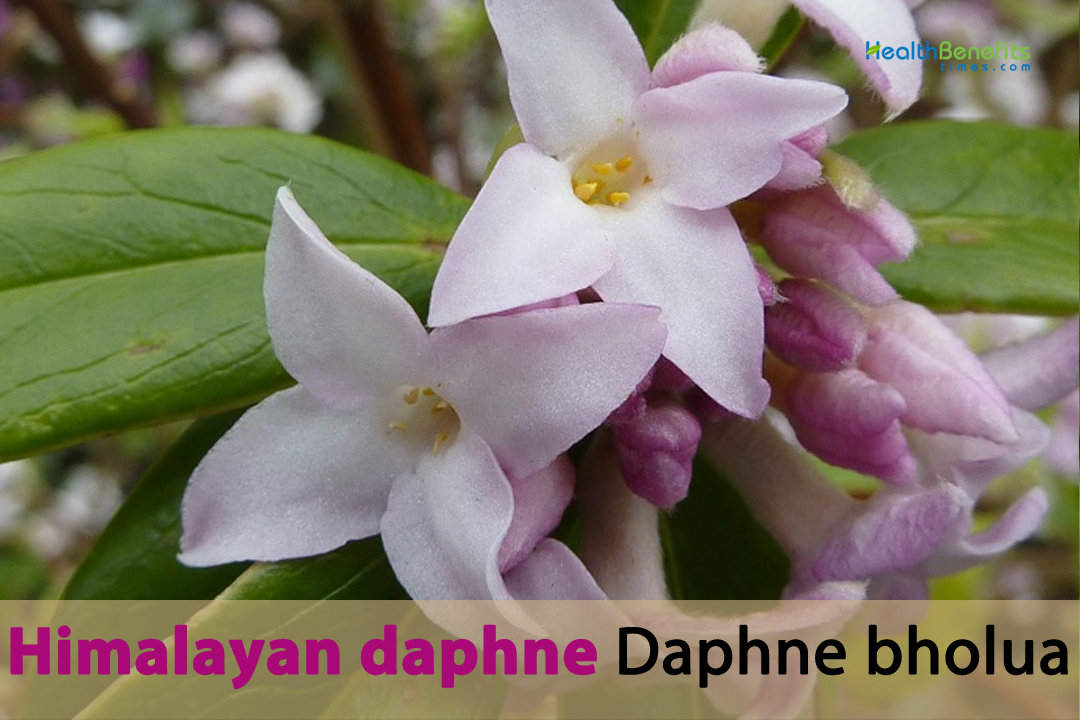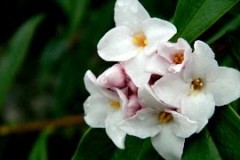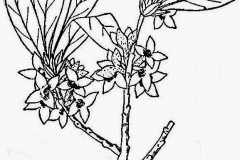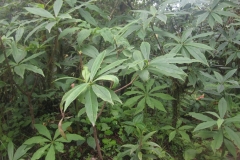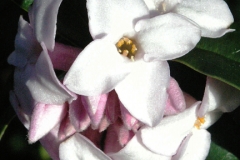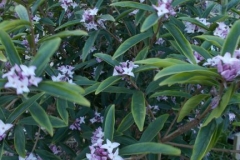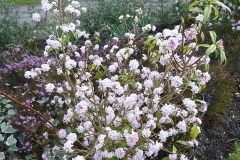| Himalayan daphne Quick Facts | |
|---|---|
| Name: | Himalayan daphne |
| Scientific Name: | Daphne bholua |
| Origin | Himalayas and adjoining ranges, from Nepal through Bhutan, India, Bhutan, Bangladesh, Myanmar and Vietnam, into Sichuan and north-west Yunnan |
| Colors | Initially green and develop a red or reddish-orange hue as they mature |
| Shapes | Small drupe measuring around 1 to 2 centimeters in diameter |
| Health benefits | Respiratory Health, Mood and Stress Support, Digestive Health, Wound Healing, Skin Health, Oral Health, Hair Care, Immune Support, Cardiovascular Health |
| Name | Himalayan daphne |
|---|---|
| Scientific Name | Daphne bholua |
| Native | Himalayas and adjoining ranges, from Nepal through Bhutan, India, Bhutan, Bangladesh, Myanmar and Vietnam, into Sichuan and north-west Yunnan |
| Common Names | Himalayan Paper Plant, Paper Daphne, Nepalese Paper Plant, Indian Paper Plant, Lokta Bush, Bhutan Paper Plant, Uttarakhand Daphne, Nepal Daphne, Sikkim Paper Plant, Bhutanese Daphne, Himalayan Spurge, Himalayan Daphne Bush, Bholua Daphne, Paperflower, Winter Daphne, Fragrant Daphne, Sweet-scented Daphne, Scented Paper Plant, Himalayan Scented Daphne, Winter Daphne, Himalayan Fragrant Spurge |
| Name in Other Languages | Afrikaans: Himalayiese Daphne Albanian: Daphne e Himalajit Arabic: Zahrat al-Himalaya (زهرة الهيمالايا) Assamese: Himalayan Daphne, Himalayi Daphni (হিমালয়ী ডাফনি) Azerbaijani: Himalaya Defnesi Belarusian: Himalayskaya dafna (Гімалайская дафна) Bengali: Bholua (ভোলুয়া), Himaloyi Daphne (হিমালয়ী ডাফনে), Himalayi Daphne (হিমালয়ী ধফনে), Daphne al-Himalaya (دافني الهيمالايا) Bhojpuri: Himalayan Daphne Bhutanese: Himalayan Daphne Bulgarian: Himalayska dafne (Хималайска дафне), Himalayska dafniya (Хималайска дафния) Burmese: Himalayan Daphne, Himalayi Daphan (ဟီမလယ် ဒာဖန်း) Chinese: Xǐmǎlāyǎ Dānbō (喜马拉雅丹波), Himalayan Daphne, Xǐmǎlāyǎ Shān Máojiǔ (喜马拉雅山毛榉), Mao hua rui xiang Croatian: Himalajska Dafna Czech: Dafna himálajská Danish: Himalaya Daphne Dutch: Himalayaanse Daphne English: Lokta plant, Nepalese paper plant Estonian: Himaalaja dafne Filipino: Himalayan Daphne Finnish: Himalajan dafne French: Daphné de l’Himalaya German: Himalaya-Spindelstrauch, Himalaya-Daphne Greek: Vounospóros tis Imalaías (Βουνοσπόρος της Ιμαλαΐας) Gujarati: Himalayan Daphne (હિમાલયન ડેફ્ને), Bholuva (ભોલુવા), Himalayan Daphne (હિમાલયન ડફની) Hindi: Bholua (भोलुआ), Bhimal (भिमल), Dhauni (धौनी) Hungarian: Himalája dafné Icelandic: Himalaja-dafna Indonesian: Himalayan Daphne Italian: Dafne dell’Himalaya Irish: Daphne Himalaia Japanese: Himarayan Dafune (ヒマラヤンダフネ), Himalayan Daphne Kannada: Bholuva (ಭೋಲುವಾ), Himalaya Daphne (ಹಿಮಾಲಯ ಡಫ್ನೆ) Kashmiri: Himalayan Daphne Kazakh: Himalay dafnasy (Гималай дафнасы) Khmer: Himalayan Daphne Konkani: Himalayan Daphne Korean: Himalaya Dapne (히말라야 답네), Himalayan Daphne Kyrgyz: Himalay dafnasy (Гималай дафнасы) Lao: Himalayan Daphne Latvian: Himalaju dafna Lithuanian: Himalajinė dafnė Macedonian: Himalajskа dafne (Хималајска дафне) Maithili: Himalayan Daphne Malay: Himalayan Daphne Malayalam: Bholuva (ഭോലുവ), Himalayathile Daphne (ഹിമാലയത്തിലെ ഡഫ്നെ), Himalayan Daphne (ഹിമാലയ ഡാഫ്നി) Marathi: Bholuva (भोलुवा), Himalayan Daphne (हिमालयन डॅफनी) Mongolian: Himalayan Daphne, Himalain dafn (Хималайн дафн) Nepali: Bholuwa (भोलुवा), Lokta (लोक्टा), Argale, Argayle, Kagate, Kaagate paate (Kagat pate), Loktaa, Sigu Norwegian: Himalaya Dafne Odia: Himalayan Daphne Polish: Dafnia himalajska Portuguese: Dáfne-do-Himalaia Punjabi: Bholua (ਭੋਲੂਆ), Himalayan Daphne (ਹਿਮਾਲਿਆਈ ਡੈਫਨੀ) Romanian: Dafinul din Himalaya, Dafinul Himalayan Russian: Gimalayskiy dafne (Гималайский дафне) Serbian: Himalaska Dafna (Хималаска Дафна) Sindhi: Himalayan Daphne Sinhala: Bholuwa (භොලුවා), Himalayan Daphne Slovak: Himalájska dafne Slovenian: Himalajski volčin, Himalajska dafna Spanish: Dáfnide del Himalaya Swahili: Daphne ya Himalaya Swedish: Himalayansk Spurge Tamil: Bholuva (போலுவா), Himalayan Daphne (ஹிமாலய டாப்னி) Telugu: Bholuva (భోలువా), Himalayan Daphne (హిమాలయన్ డఫ్నే) Thai: Himalayan Daphne Tibetan: Dpal-bod Yon-tan (དཔལ་བོད་ཡོན་ཏན།), Shugu (བཤུ་གུ), Himalayan Daphne Turkish: Himalaya Çuhaçiçeği, Himalaya Defnesi Ukrainian: Dafna himalayska (Дафна гімалайська), Himalayska dafna (Гімалайська дафна) Urdu: Himalayan Daphne (ہمالیاں ڈیفنی) Vietnamese: Himalayan Daphne, Daphne Himalaya, Dó bô lua |
| Plant Growth Habit | Deciduous or semi-evergreen shrub |
| Growing Climates | Clearings in oak and rhododendron forests, shrubberies, pastures and grassy glades |
| Soil | Favors organic-rich, well-draining soil. Ideal pH levels range from mildly acidic to neutral (around 6 to 7) |
| Plant Size | Around 1 to 3 meters (3 to 10 feet) tall and 1 to 2 meters (3 to 6 feet) wide |
| Root | Root system of Himalayan daphne is composed of fine, fibrous fibers. These roots are relatively thin and highly branched, producing a dense network near the soil surface that extends horizontally |
| Stem | Stems are thin, brittle typically has a brownish hue and a smooth or slightly gritty texture |
| Bark | Bark is smooth and papery or parchment-like in appearance. It is delicate to the touch and peels off readily in thin layers |
| Leaf | Simple, alternate, and elliptical in shape. They are usually leathery, glossy, and dark green in color. The leaves emit a pleasant fragrance when crushed or bruised. |
| Flowering season | Late December to March |
| Flower | Plant produces clusters of fragrant flowers. The flowers are tubular and usually pale pink to white in color. They bloom during late winter or early spring, often before the leaves emerge. The fragrance of the flowers is strong and appealing |
| Fruit Shape & Size | Small drupe measuring around 1 to 2 centimeters in diameter |
| Fruit Color | Initially green and develop a red or reddish-orange hue as they mature |
| Seed | Generally oval or ellipsoid in shape, typically small, measuring around 3 to 5 millimeters in length |
| Flavor/Aroma | Sweet, spicy, and floral |
| Plant Parts Used | Bark and roots |
| Propagation | By seed, Stem Cuttings, Layering and Grafting |
| Lifespan | Thrive and persist for 20 to 30 years or even longer |
| Season | April -May |
| Major Nutrition |
|
| Varieties |
|
| Health benefits |
|
Plant Description
Himalayan daphne is a deciduous or semi-evergreen shrub that grows approximately 1 to 3 meters (3 to 10 feet) tall and 1 to 2 meters (3 to 6 feet) wide and has an upright growth tendency. The plant grows in oak and rhododendron woodland clearings, shrub lands, pastures, and verdant glades. The plant favors organic-rich, well-drained soil. Ideal pH levels range from mildly acidic to neutral (around 6 to 7). Ensure that the soil does not become saturated with water, as too much moisture can cause root decay. Numerous cultivars of Himalayan daphne are cultivated as ornamental plants in Europe and North America. It has leathery leaves and intensely fragrant, deep pink flowers.
Appropriate growing environment for Himalayan daphne
Himalayan Daphne is a flowering plant that thrives in specific environmental conditions. Here are some key factors to consider when creating an appropriate growing environment for Himalayan Daphne:
- Climate: Himalayan Daphne prefers temperate to cold climates. It thrives in regions with temperate summers and frigid winters. It can tolerate frost and even some snow, but extreme winter conditions may necessitate protection.
- Sunlight: Typically, Himalayan Daphne grows best in partial shade or filtered sunlight. It can tolerate full sun, but may benefit from shade during the hottest portion of the day, particularly in regions with intense summer heat.
- Soil: It favors organic-rich, well-draining soil. Ideal pH levels range from mildly acidic to neutral (around 6 to 7). Ensure that the soil does not become saturated with water, as too much moisture can cause root decay.
- Watering: While Himalayan Daphne requires consistent irrigation, it is essential not to overwater. The soil must be kept moist without becoming inundated. Allow the upper soil layer to become slightly dry between watering.
- Humidity: In general, moderate humidity levels are suitable for Himalayan Daphne. If you reside in a particularly dry climate, you can add humidity to the air by misting the plant’s leaves or placing a tray of water nearby.
- Protection from Wind: Himalayan Daphne is susceptible to injury from strong winds, which can harm its delicate branches. Planting it in an area that provides some protection from intense gusts or constructing a windbreak can help protect the plant.
- Pruning: Regular pruning can aid in maintaining the plant’s form and promote healthy development. After flowering, prune to promote new growth and remove any damaged or deceased branches.
Roots
The root system of Himalayan daphne is composed of fine, fibrous fibers. These roots are relatively thin and highly branched, producing a dense network near the soil surface that extends horizontally. Typically, they are shallow and do not penetrate the ground profoundly. The fibrous root system is well acclimated to its natural environment in the Himalayan alpine and subalpine regions. The fine root filaments that cover the fibrous roots significantly increase the available surface area for water and nutrient absorption. This efficient absorption mechanism enables the plant to fulfill its growth and survival needs in the difficult mountain environment.
The fibrous root system of the Himalayan daphne serves a role in its vegetative propagation. Some Daphne species are capable of producing adventitious roots from their stems or branches. When the stem or branch makes contact with the soil, these adventitious roots can develop into new plants, allowing for vegetative reproduction.
Stem
Typically, stems are thin and brittle. It can reach a height of several meters, but the exact size can differ depending on the plant’s specific environment and age. The stem typically has a brownish hue and a smooth or slightly gritty texture. The stem has a branching structure. Lateral branches emerge from the main stem as the plant matures, resulting in an unkempt or shrub-like growth habit. The branching is typically irregular and somewhat dense, giving the tree a robust aspect. The stem grows upright and has a faint arching or leaning shape. The plant has a compact growth habit, and its stems frequently intertwine, producing the appearance of a dense thicket.
Bark
Bark is smooth and papery or parchment-like in appearance. It is delicate to the touch and peels off readily in thin layers. The color of the bark varies based on the plant’s age and environmental conditions. It is typically light brown or light grey, but can also have traces of green or crimson. Lenticels are tiny, corky pores or patches located on the bark’s surface. They permit the exchange of gases between the plant’s inner tissues and the external atmosphere.
The thin bark is renowned for its ability to readily peel away in thin strips or sheets. This quality has made it a popular material for traditional crafts such as papermaking and the production of handmade paper. As a result of the configuration of leaf scars and bud scales, the bark often displays distinct patterns. These patterns can vary among species and serve as identifiers. When the bark of certain species of daphne, including Himalayan daphne, is crushed or fractured, a pleasant scent is released.
Leaves
The leaves are alternately arranged along the stems. This means that each leaf emerges from a different location along the stem, producing a staggered appearance. In general, leaves are lanceolate, which means they are elongated and narrow, with a pointed apex. Some leaves are marginally broader or more ovate in outline than others. Typically, the leaf margins are entire, which means they are smooth and devoid of serrations or fangs. The leaf margins are typically smooth and mildly curved.
The prominent veins of leaves run parallel to the leaf margins. These veins aid in the transport of water and nutrients throughout the leaf, and they also provide structural support. The upper surface of the foliage is glossy and smooth, while the lower surface is paler and may be matte or slightly rough. Depending on environmental conditions and the maturity of the foliage, leaf color can vary. The leaves are typically dark green, but they can also be bluish-green. In general, the leaves are tiny to medium in size, ranging in length from about 5 to 10 centimeters. The Himalayan daphne is an evergreen shrub, meaning it retains its foliage year-round. The foliage neither change color nor fall with the seasons.
Flower
Typically, flowers are petite and bell-shaped. They are cylindrical or tubular in shape with a flared or slightly rounded orifice. The diameter of the flowers can differ, but is typically between 1 and 2 centimeters. The individual blooms are relatively small, but their clustered growth creates a striking display. The flowers can be a variety of hues, including white, ivory, light pink and light purple. The precise hue may differ based on the cultivar or environmental conditions. Typically, the flowers have four or five petals that are fused at the base. These petals extend outward to create the flower’s bell or tube-like structure. The edge of the petals may be smooth or faintly undulating.
A notable characteristic of flowers is their pleasing aroma. The flowers frequently emit a sweet, lingering fragrance that can be appreciated up close. Inside of the flower are the reproductive organs. The male parts of a flower are the stamens, which comprise of several filament-like structures topped by anthers that produce pollen. The pistil, the female part of the flower, comprises of the stigma, style, and ovary and is located in the center. Himalayan daphne typically blossoms from late winter to early spring, bringing with it a burst of color and fragrance.
Fruits
This is a petite drupe fruit. A drupe is a variety of fruit with a fleshy outer layer (exocarp), a hard or stony interior layer (endocarp), and an internal seed. Typically, the diameter of the melons ranges between 1 and 2 centimeters. They can vary in size marginally depending on the species or cultivar. When they are juvenile and immature, fruits initially appear green. As they mature, their color typically changes to red or reddish-orange. The precise hue and color may vary based on the cultivar or environmental conditions. The fruit’s outermost layer (exocarp) is smooth and may have a waxy or faintly glossy appearance. As a fruit ripens, the exocarp becomes mushy and fleshy, making it simpler to extract the seed contained within. The fruits are dispersed predominantly by birds. The fleshy fruit is consumed by birds, while the seeds travel through their digestive systems. The seeds are then disseminated by the bird’s droppings, contributing to the plant’s propagation and spread. Typically, the crops mature in late summer or early autumn. The fruits are now completely coloured, and the exocarp has become soft and fleshy. You can harvest them by delicately plucking them from the plant.
Seeds
In general, seeds are ovoid or ellipsoid in shape. They have a rounded and sleek exterior. The length of the seeds can differ slightly, but is typically between 3 and 5 millimeters. The precise measure may vary depending on the species or cultivar. The seed coat is the protective outer membrane that covers seeds. The seed coat is typically thin, silky, and light brown to dark brown in color. Inside the seed coat is the embryo, which represents the earliest stage of plant development. The embryo includes the embryonic leaves (cotyledons) and the developing point (apical meristem).
Endosperm may exist as a nutrient-rich tissue surrounding the embryo. As the embryo germinates and begins to grow, the endosperm provides nourishment. When conditions are favorable, the seed germinates, at which point it absorbs water and initiates embryo development. After the embryo emerges from the seed coat, root and shoot development commences. Birds are the primary dispersers of the seeds. The fleshy fruits are consumed by birds, while the seeds transit through their digestive systems. The seeds are then disseminated by the bird’s droppings, contributing to the plant’s propagation and spread.
Varieties of Himalayan daphne
Himalayan daphne is a species of flowering plant that belongs to the family Thymelaeaceae. It is native to the Himalayan region, specifically found in countries like Nepal, Bhutan, and India. Himalayan daphne is a highly diverse plant species, and several varieties or subspecies exist within this species. Here are some notable varieties of Himalayan daphne:
- Daphne papyracea var. papyracea: This is the standard Himalayan daphne variety, distinguished by its papery, white or pale yellow blossoms. It is a small to medium-sized shrub that can reach heights of 1-2 meters. The plant has oblong or lanceolate leaves, and it blossoms in the spring.
- Daphne papyracea var. alba: This species of Himalayan daphne is renowned for its white blooms. It has a comparable appearance to the typical variety, but its flowers are a different hue. The shrub’s elegant appearance is enhanced by its white blossoms, making it a popular choice among gardeners.
- Daphne papyracea var. feruginea: This variety is distinguished by its blossoms that are reddish or copper-colored. The flowers have a vibrant hue that distinguishes them from other varieties. The remaining characteristics of the plant are comparable to those of the typical variety.
- Daphne papyracea var. bhutanica: This variety is native to Bhutan and is renowned for being marginally larger than other varieties. It has broader leaves and larger, typically white or pale yellow flowers. The flowering season is comparable to that of other varieties; it occurs in the spring.
- Daphne papyracea var. flava: This cultivar is distinguished by its yellow blossoms. The bright yellow or golden-colored flowers lend a cheery touch to the shrub. The leaves and other characteristics resemble those of the typical variety.
- Daphne papyracea var. himalaica: This variety is indigenous to the upper Himalayan altitudes and is adapted to colder climates. It is a resilient variety with smaller foliage and flowers than other types. Typically, the blossoms are pale yellow or white.
- Daphne papyracea var. glomerata: This variety is distinguished by its flowers, which form dense clusters or heads at the branch ends. The flowers are typically white or pale yellow in color and have a pleasant scent. The glossy, elongated leaves provide a beautiful backdrop for the blossoms.
- Daphne papyracea var. rubra: This variety is characterized by its reddish or pinkish blossoms, as suggested by its name. The flowers can range in color from pale pink to deep red, giving the shrub a splash of vivacious color. The plant’s leaves resemble those of the typical variety, and it blossoms in the spring.
- Daphne papyracea var. purpurea: This variety is recognized for its violet or violet-red blossoms. The flower’s distinctive hue distinguishes it in gardens and landscapes. The plant’s leaves are typically lanceolate or oblong, and it blossoms in the spring.
- Daphne papyracea var. aurantiaca: The flowers of this variety are orange or orange-red. The flower’s vibrant and eye-catching hue lends a touch of warmth to the landscape. The plant has similar growth characteristics and foliage to the standard variety and it blossoms in spring.
- Daphne papyracea var. concolor: This cultivar is distinguished by its uniformly coloured flowers. The flowers are typically white, pale yellow or pale pink, lacking the multicolored or variegated patterns of other species. The leaves are glossy and elongated, giving the shrub a refined appearance.
- Daphne papyracea var. nanum: This variety is a dwarf variant of Himalayan daphne, typically growing to less than 1 meter in height. It has fewer leaves and flowers than other varieties, but it retains the species’ allure and fragrance. It is a fantastic option for tiny gardens and containers.
- Daphne papyracea var. multiflora: This variety is renowned for its abundant flowering. It produces a profusion of flowers along its branches, producing a magnificent display. Typically, the flowers are white or pale yellow and emanate a sweet scent. The plant’s growth characteristics and foliage resemble those of the average variety.
- Daphne papyracea var. leucantha: This variety is characterized by its clusters of white flowers. The flowers are densely clustered on the plant’s branches, producing dense, cone-shaped clusters. The white flowers contrast wonderfully with the dark green leaves of the plant.
- Daphne papyracea var. recurvifolia: This variety is recognized for its distinctive foliage. The distinctively recurved or curled leaves of this daphne lend an interesting textural element to the plant. The springtime blossoms are typically white or pale yellow.
- Daphne papyracea var. grandiflora: As suggested by its name, this variety is distinguished by its large blossoms. The flowers may be considerably larger than those of other varieties, making them the plant’s focal point. The flowers are typically white or pale yellow in color and emanate a pleasant scent.
- Daphne papyracea var. maroonii: This variety is distinguished by its maroon-colored blossoms. The blooms’ deep, rich hues create a startling contrast with the plant’s foliage. It gives any garden or landscape a touch of dramatic elegance.
- Daphne papyracea var. variegata: This variety is distinguished by its variegated leaves. Even when the plant is not in bloom, the leaves’ combination of green and pearly white or yellow markings adds visual interest. The flowers are typically white or pale yellow, and they emerge in the springtime.
Health benefits of Himalayan daphne
Himalayan Daphne is a plant native to the Himalayan region. It has been used for centuries in traditional medicine systems like Ayurveda and Tibetan medicine for its various health benefits. While it’s important to note that scientific research on Himalayan Daphne is limited, the plant is believed to possess several potential health-promoting properties. Here are some of the commonly attributed health benefits:
1. Respiratory Health
Himalayan Daphne is frequently utilized to promote respiratory health. It is thought to have expectorant properties, which may aid in loosening and expelling mucus from the airways. It is frequently employed in traditional remedies for coughs, colds, bronchitis, and other respiratory disorders.
2. Anti-inflammatory Effects
It is believed that the plant has anti-inflammatory properties that can help reduce inflammation in the body. This property may aid in the treatment of conditions such as arthritis, joint pain, and inflammatory skin disorders.
3. Antimicrobial Activity
Himalayan Daphne is believed to have antimicrobial properties, meaning it may aid in the struggle against microorganisms such as bacteria and fungi. Traditional applications include treating skin infections, wounds, and other microbial-related conditions with the plant.
4. Mood and Stress Support
Some traditional practices employ Himalayan Daphne for its potential sedative and mood-boosting properties. It can reduce tension, anxiety, and mild mood disorders. It is essential to note, however, that the scientific evidence supporting these claims is limited.
5. Anti-diabetic Effects
It is believed that Himalayan Daphne possesses hypoglycemic properties, which may aid in regulating blood sugar levels. To validate these claims and ascertain the safety and efficacy of Himalayan Daphne for diabetes management, however, rigorous scientific research is required.
6. Digestive Health
Traditional medicine uses Himalayan Daphne to support digestive health. It is believed to have carminative properties, which may aid in alleviating gas, bloating, and indigestion. It is also used to promote healthy digestion and stimulate the appetite.
7. Wound Healing
Traditionally, the plant is applied topically for its potential wound-healing properties. Crushed Himalayan Daphne leaves or bark is occasionally applied to incisions to promote healing and prevent infection. However, it is essential to note that serious wounds require appropriate wound care and medical attention.
8. Anti-allergic Effects
Himalayan Daphne is used in some traditional practices to alleviate allergy symptoms. It is believed to have anti-allergic properties that can alleviate symptoms such as sneezing, itching, and nasal obstruction. However, there is no scientific evidence to substantiate these claims.
9. Antioxidant Activity
It is believed that Himalayan Daphne contains compounds with antioxidant properties. Antioxidants assist in protecting the body from oxidative stress and free radical injury. Although Himalayan Daphne’s antioxidant potential has not been extensively investigated, it may contribute to overall health and wellbeing.
10. Skin Health
Himalayan Daphne has traditionally been utilized for its prospective skin benefits. It is believed to possess skin-health promoting and skin-condition relieving properties. The plant’s extracts can be applied topically to relieve irritated skin, diminish redness, and hydrate dry skin. However, individual sensitivities and allergies can vary, so it is recommended to conduct a patch test prior to applying it to larger areas of skin.
11. Anti-aging Properties
Himalayan Daphne’s antioxidant content may contribute to its potential anti-aging properties. Antioxidants assist in neutralizing free radicals and decreasing oxidative stress, both of which can contribute to premature aging and skin injury. Although Himalayan Daphne’s anti-aging properties have not been extensively studied, its antioxidant activity may promote overall skin health.
12. Oral Health
In some traditional practices, Himalayan Daphne is used for oral health. It is believed to possess antibacterial properties that may aid in the fight against oral bacteria responsible for tooth decay, gum disease, and bad odor. It is essential to note, however, that oral health requires comprehensive care, including regular dental hygiene practices and visits to a dentist.
13. Hair Care
Due to its possible advantages for the scalp and hair, Himalayan Daphne is occasionally used in hair care products. It may assist in relieving an irritated scalp, reducing dandruff, and promoting healthier hair. For this purpose, some traditional remedies incorporate Himalayan Daphne extracts or oils into hair masks or cleansers. However, the scientific evidence supporting its effectiveness in hair care is scant.
14. Immune Support
It is believed that Himalayan Daphne has immune-enhancing properties. It is utilized by traditional medical systems to strengthen the immune system and support its overall function. However, scientific investigations are required to validate these claims and comprehend the underlying mechanisms.
15. Analgesic and Anti-inflammatory Effects
Himalayan Daphne is occasionally used traditionally for its potential analgesic and anti-inflammatory properties. It can be used to relieve mild to moderate pain, including migraines, muscle aches, and joint pain. However, additional research is necessary to identify the compounds responsible for these effects and their precise mechanisms of action.
16. Anticancer Potential
Some preliminary research indicates that certain compounds found in Himalayan Daphne may have anticancer properties. In laboratory investigations, it was discovered that these compounds exhibit cytotoxic activity against specific cancer cell lines. It is crucial to note, however, that additional research, including clinical trials, is required to determine its efficacy and safety as a cancer treatment.
17. Cardiovascular Health
Himalayan Daphne is thought to have prospective cardiovascular health benefits. It may assist in lowering blood pressure, enhancing blood circulation, and promoting cardiac health. However, scientific evidence in this regard is limited, and it is essential to rely on established treatments for cardiovascular disorders.
Traditional uses and benefits of Himalayan Daphne
- Juice of the roots, combined with molasses, is used in the treatment of fevers and intestinal problems.
- Decoction of the bark is used to treat fevers.
- Powdered seeds are anthelmintic.
- Bark and roots are used in traditional medicine in Nepal to treat fevers.
Different uses of Himalayan daphne
Himalayan daphne has various uses beyond culinary applications. Here are some different uses of Himalayan daphne:
- Ornamental Plant: Due to its beautiful and fragrant flowers, Himalayan daphne is predominantly grown as an ornamental plant. It is a popular choice for gardens, landscapes, and floral arrangements due to its appealing foliage and delicate flowers.
- Handmade Paper: Handmade paper is produced from the inner bark of Himalayan daphne, also known as lokta. Traditional papermaking involves soaking, cooking, pounding, and drying the pulp to create sheets of durable and textured paper. Lokta paper is valued for its durability, longevity, and eco-friendliness, and it is frequently employed for a variety of craft, stationery, and artistic applications.
- Incense and Fragrance: Sometimes, the bark leaves, and roots of Himalayan daphne are used to produce incense or impart fragrance to products. The pleasant fragrance of the plant, reminiscent of honey or citrus, can be used in natural perfumes, soaps, candles, and other aromatic products.
- Soil Stabilization and Erosion Control: Himalayan daphne is planted in some areas to prevent soil erosion on slopes and stabilize the soil. Its deep root system reduces the danger of landslides and soil erosion in vulnerable areas by binding the soil.
- Natural Fibers and Crafts: Lokta fiber, also known as the interior bark of Himalayan daphne, is utilized in the creation of traditional crafts. Lokta fibers are robust and long-lasting, making them ideal for weaving into cords, baskets, mats, and other handicrafts.
- Herbal Bathing: In herbal bathing, infusions or extracts produced from the bark or leaves of Himalayan daphne can be utilized. It is believed that these herbal baths have restorative or therapeutic effects on the epidermis and overall health.
- Aromatic Potpourri: The aromatic flowers, foliage, and bark of Himalayan daphne can be used to create potpourri. The plant’s pleasant aroma imparts a natural and refreshing perfume to interior spaces.
- Natural Pesticide: In some traditional agricultural practices, extracts or infusions of Himalayan daphne are used as a natural pesticide. It is believed that the plant’s noxious compounds have insecticidal properties and can aid in crop protection.
- Traditional Paper Crafts: Himalayan daphne fibers can be used for paper-related crafts besides handmade paper. The fibers may be incorporated into paper mache, papier-maché, paper sculptures, and other works of art.
- Traditional Textile Techniques: In certain regions, traditional textile techniques incorporate Himalayan daphne fibers. They can be combined with other natural fibers or used alone to create distinctive, textured fabrics for apparel, bags, and accessories.
- Cultural Symbolism: Some communities place cultural significance on Himalayan daphne. It may represent purity, tenacity, or be associated with particular rituals, celebrations, or folklore.
- Wildlife Habitat: The Himalayan daphne provides habitat and food sources for numerous species of fauna. The flowers attract pollinators such as bees and butterflies, while birds and small mammals may consume the fruits and seeds.
- Dyeing: The foliage of Himalayan daphne is a natural source of dye. When used to dye fabrics or fibers, it generates yellow, brown, and beige tones. This makes it a useful resource for artisans and textile enthusiasts looking for natural dyeing materials.
- Handicrafts and Artwork: The stems and branches of Himalayan daphne can be used in a variety of handicrafts and works of art. They can be woven or bent to create baskets, headgear, and decorative items, as well as used for sculpture and artistic creations.
- Traditional Rituals and Ceremonies: Himalayan daphne may have symbolic significance and be utilized in rituals and ceremonies in certain cultural traditions. It can be used in spiritual practices, offerings, and decorations.
- Insect Repellent: Reportedly, the aroma of Himalayan daphne repels certain insects, including mosquitoes. In some regions, the plant’s desiccated leaves or branches may be burned as a natural insect repellent.
- Traditional Craftsmanship Tools: The durability and pliability of Himalayan daphne wood makes it suitable for the construction of traditional tools and implements. For instance, the wood can be utilized to create miniature handles, weaving tools, and musical instrument components.
- Ethno-botanical Research: Like many other plant species, the Himalayan daphne is of interest to researchers and ethno-botanists. It may be investigated for its cultural significance, traditional applications, chemical composition, and possible pharmacological properties.
Side effects of Himalayan daphne
Himalayan Daphne is a flowering plant native to the Himalayan region. While it is primarily appreciated for its fragrant flowers and attractive appearance, it’s important to note that certain parts of the plant, especially the bark and roots, contain toxic compounds that can cause various side effects if ingested or handled improperly. Here are some potential side effects of Himalayan Daphne:
- Skin Irritation: The sap or any other portion of the plant may cause skin irritation, redness, itching, or a rash if it comes into direct contact with the skin. When handling the plant, it is recommended to wear gloves to reduce the danger of skin reactions.
- Gastrointestinal Issues: Any part of the Himalayan Daphne plant that is consumed can cause gastrointestinal distress, including vertigo, vomiting, abdominal pain, and diarrhea. The severity of these symptoms may differ depending on the amount consumed.
- Respiratory Problems: Inhaling the dust or particles from dried Himalayan Daphne can cause respiratory irritation and difficulty inhaling, particularly in individuals with preexisting respiratory conditions such as asthma or bronchitis.
- Eye Irritation: If the plant’s sap or any other component comes into contact with the eyes, it can cause irritation, redness, weeping, and discomfort. In such instances, it is advised to immediately flush the eyes with clean water.
- Allergic Reactions: Some people may have an allergy to Himalayan Daphne or its constituents. Allergic reactions may range from modest signs like itching and hives to more serious appearances like face or throat swelling, difficulty breathing and anaphylaxis. If you experience any signs of an allergic reaction, you must seek instant medical attention.
- Poisoning: Significant consumption of Himalayan Daphne can result in poisoning. The plant’s toxic compounds can affect the central nervous system, causing symptoms such as confusion, vertigo, weakness, convulsions, coma, or death in extreme cases. Avoid ingesting the plant’s foliage or roots, as they are especially hazardous.
References:
https://pfaf.org/user/Plant.aspx?LatinName=Daphne+bholua
http://www.theplantlist.org/tpl1.1/record/kew-2756860
https://en.wikipedia.org/wiki/Daphne_bholua
https://gd.eppo.int/taxon/DAPBH
https://en.hortipedia.com/Daphne_bholua
https://temperate.theferns.info/plant/Daphne+bholua
http://www.naturalmedicinalherbs.net/herbs/d/daphne-bholua.php


